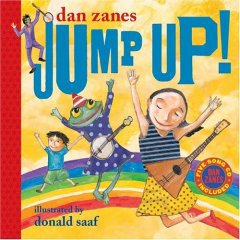In keeping with my role as the frivolous member of this book club, I present the second installment of my Children's Book Roundup.
I'll begin with some recent library check-outs. The first is
Jump Up!, by Dan Zanes, illustrated by Donald Saaf.

Now let it be known that I am a fan of
Dan Zanes generally. His lifestyle, which seems mainly to consist of playing folk music with his friends, teaching himself Spanish, shopping at thrift stores with his daughter, and generally hanging out on his stoop in Brooklyn, would be the life I would lead if I a) had rhythmn and b) was independently wealthy. His flotilla of CDs are fun to listen to, especially if, like me, you like to pass the time with your family by singing your way through the Fireside Book of Folk Songs. But
Jump Up!, to be polite, is a weak effort. Saaf's illustrations are joyful, and OlderKid digs the book for that reason, but I think there's also a reason he never wants to listen to the accompanying CD. The words are, as platitudes always are, flat boring. Two other choices at the library also struck out.
The Problem with Chickens, by Bruce McMillan, illustrated by Gunnella, despite being a New York Times Best Illustrated Book, suffers from several deficiencies. First of all, Aliki should be the only one-named children's book illustrator. Second, the story is needlessly convoluted. The titular problem, that these Icelandic ladies' chickens won't produce eggs, is inexplicably solved by having them do arm exercises and nest on a cliff. OlderKid was unimpressed by this "ending."
Leopold, the Liar of Liepzig, was just plain ugly. 'Nuff said.
Our big success, however, was the ominously titled
When Sophie Gets Angry--Really, Really Angry.... Various cranky Amazon reviewers have complained that this book teaches children to run away into the woods when they are mad. These are the same kind of literal minded people who, in my lit classes, complain that Alice should have gotten hurt after falling all that way down the rabbit hole. OlderKid, who is currently deeply involved in the project of anger management, found this book to be a revelation, and he asks for it again and again and again. I don't mind because the text and pictures are so simple yet so perfect for each other, and also because I need help remembering what to do when I'm angry too. It goes pretty well with James Marshall's
Hansel and Gretel, which is both alluring and disturbing to OlderKid. "Is that the witch burning up in the chimney," he asks, more as a statement than a question. "Did Gretel push her there."
On to some birthday gifts.
Animals should definitely not Wear Clothing is exactly what it sounds like, funny and straightforward, plus (given its 1960s publication date) a humorous reminder of how people used to dress.
Martha Blah Blah, about a dog that gains and then loses the ability to speak with the help of canned alphabet soup, is hilarious to me but a little beyond OlderKid's comprehension. The divine
Frog and Toad are Friends hardly needs my recommendation here; it's not
The Known World, maybe, but if you don't own it you've got a bookstore visit to make post-haste. The last story, in particular, can reliably make me cry if I start thinking about it too hard. One last book that was new to me but is quickly climbing up to favorite book status is William Steig's
The Amazing Bone.

This tells the story of a young pig named Pearl who, while taking the long route home from school, discovers a talking bone lying lonely in the forest. The two ramble along happily until a lascivious fox appears and imprisons Pearl, intending to eat her for dinner. The following exchange maybe captures what I love about the book:
"I hope it won't all take too long," said Pearl. She could smell vinegar and oil. The fox was preparing a salad to go with his meal. Pearl hugged the bone to her breast. "Bone, say something to comfort me."
"You are very dear to me," said the bone.
"Oh, how dear you are to me!" Pearl replied. She could hear a key in the lock and was unable to get another word out of her throat or turn her eyes towards the door.
Is there nothing Stieg can't do? Suspense, horror even, humor, and real sympathy and love, all captured in the relationship between a pig in a pink dress and bonnet and the tiny bone she keeps in her purse. Needless to say, Pearl escapes, and it's so satisfying for both me and OlderKid that some nights we only want to read this book and it's enough. I know there are lots of people who don't have any interest in what children read until they get old enough to read "real" literature, but I'd set
The Amazing Bone against those "real" books any day.
P.S. I know this post is long, but one more thing. As I was driving OlderKid and YoungerKid to daycare today, I was telling OK why YK couldn't sing "I've been working on the railroad" with us. "[YK] doesn't talk," I said. A look of absolute indignation crossed OK's face. "Yes he does, Mama," he replied. "He talks to ME." And it's true, he does, and he loves books too, even if his fingers are too chubby to always turn the pages easily. Currently, he loves the collected works of Byron Barton, especially
My Car.







